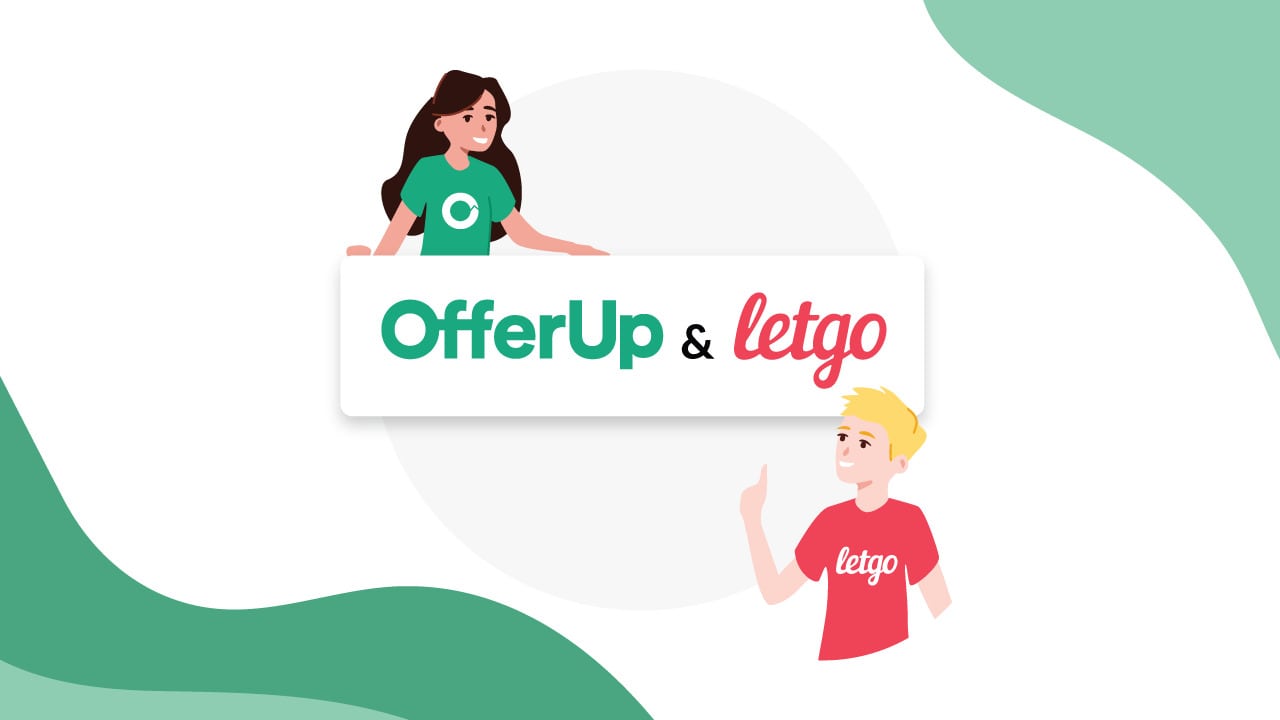Building the Best Marketplace App: Development Stages, Features Guide, and More
Mobile boom made the interaction between the client and the seller closer, and all the data required is in mobile gadgets now. Users benefit from it by ordering things worldwide, so attracting customers became a simple process. But remember that most people prefer delivering the ordered packages from nearby places, not from long distances. That’s why such apps as OfferUp vs LetGo will be reliable helpers in such operations both for customers and purchasers.
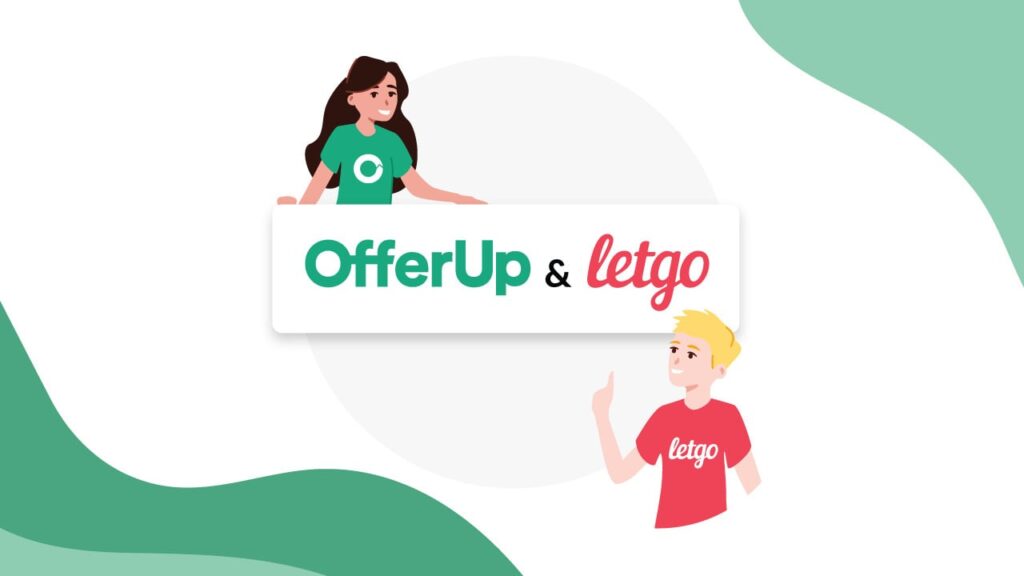
For you to know more about developing a LetGo-similar app, we have prepared this post. You will also learn more about such products’ basic and additional functionality, the steps to develop them, and more of exciting information.
The Buy-and-Sell-Apps: Stages to Create
Let’s discuss what stages the OfferUp-like concept should pass through to become a full-fledged marketplace app.
- Conducting the top-selling apps’ market study
- Preparing a business model of the future application
- Defining a solution stack to create an app
- Choosing the fundamental functionality to add
- Making a catchy logo
- Creating an appealing interface as well as the good user experience
- Implementing a shopping cart to the app
- Caring about a payment system implementation
- Organizing a marketing campaign for your solution
- Thinking about anti-fraud measures
The Best Apps for Local Purchasing
The purchasing solutions (that include mobile apps and desktop ones) are prevalent among commercial software products. According to Statista, the e-commerce market profit is going to amount to $2,723,991 million by the end of 2021. Its annual growth rate will become 6.25% by 2025, and the market value will reach $3,477,296 million. To figure out a reason for these apps’ popularity, we’ll look closer at them.
Applications like Offer Up and LetGo allow sellers to give away the used things for free, which is a trait that they both have in common. It’s an attractive option to get rid of certain little goods that are profitless to sell on eBay.
The OfferUp App
This application is the largest and secure e-commerce platform for buyers and sellers. Each app’s user may build a reputation on their account. It can be done the following way (similar to eBay’s one): every customer who had a trading operation with a certain seller can grade them after the deal. The users can also confirm their page identity by joining the TryYou service and adding their ID number.
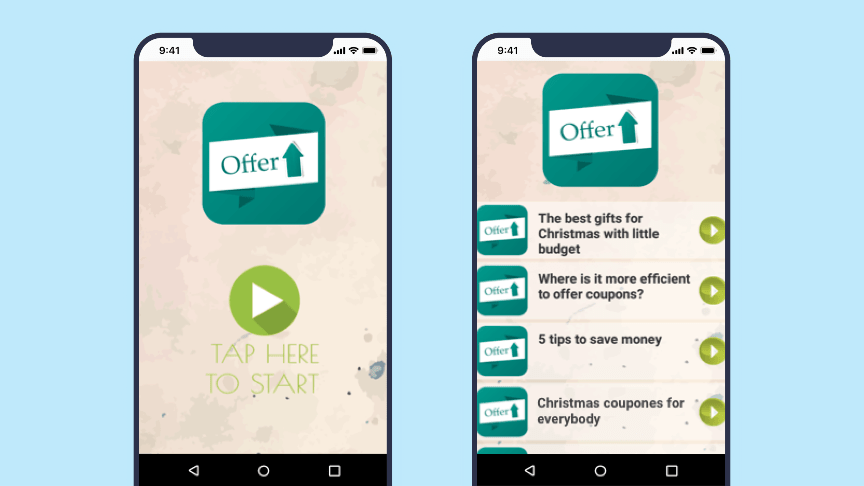
The OfferUp application screens
The OfferUp bargains are settled face to face despite the built-in user chat. According to the app developers, the product use is so comfortable that people spend roughly 25 minutes a day — the similar daily time Snapchat and Instagram are used on average.
The LetGo App
The app opens an opportunity to sell things quickly and safely in a particular location. First off, you can log in through the Facebook account, which helps the service check users’ personal information and look after security issues. The communication between buyers and sellers is carried out through chat. There you can also upload the images (taken with the help of the implemented app camera) of the articles that have to be quickly sold.
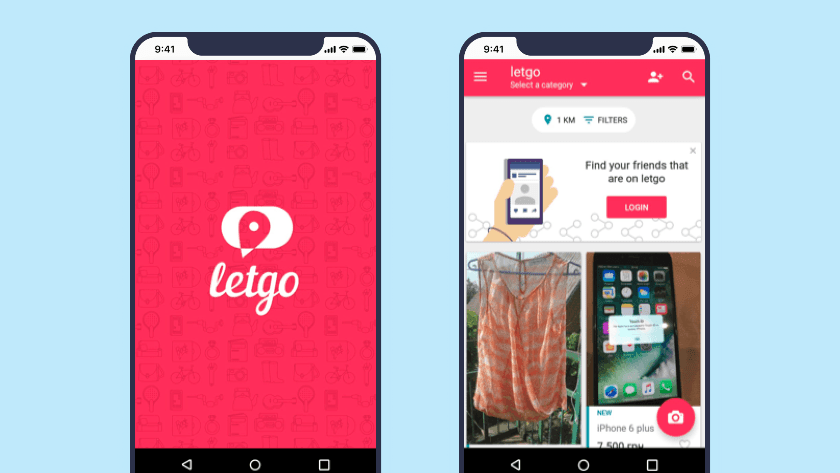
The LetGo application screens
In September 2020, OfferUp purchased LetGo, which became twice as beneficial for the users helping them do business quickly and conveniently and connecting buyers and sellers.
The Business Model of LetGo vs OfferUp-Similar Applications
The LetGo and OfferUp apps help people purchase and sell used goods following the business model that allows gaining profit through ads. At the same time, such operations as account creation or making a trade are free of charge.
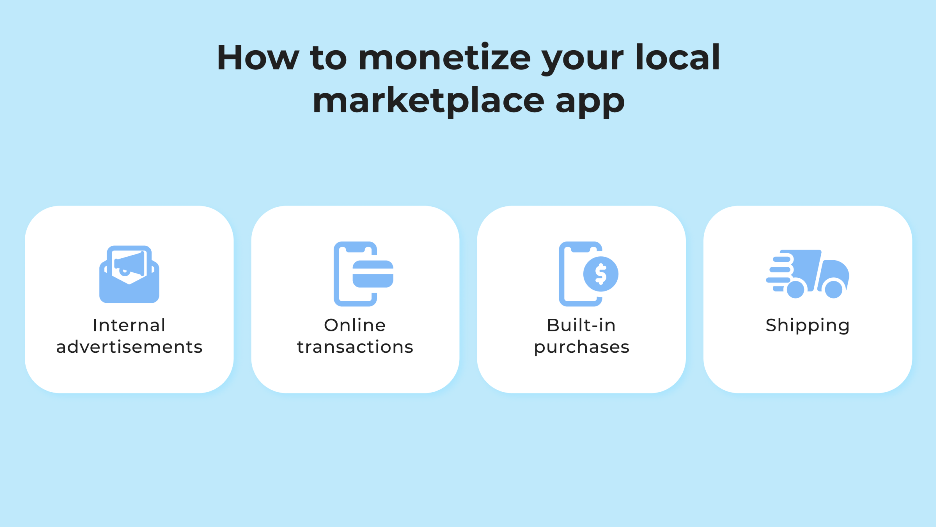
Strategies for monetizing the marketplace apps
Let’s find out the strategies of monetization you can implement in your LetGo or OfferUp-like application.
- Internal advertisements. It is possible to promote an inside referral system, unique offerings, and other information concerning your product.
- Online transactions. You can get a fixed price or a percentage from every bargain in case the customers make payments via your app. It can be easily done through Stripe-like third-party services.
- Shipping. Your platform can assist sellers in expanding their trading area, serving as a mediator between traders and customers.
- Built-in purchases. This option is required to obtain the sellers’ charges for the ads placed in your app or buying special offers.
The Tools and Services Required
There is an example of a technology stack that will help you create an OfferUp-like application:
The backend: Node.js, Express.js
The frontend: Bootstrap, JS, HTML, CSS
Languages: Java or Kotlin (for Android-based apps), Objective-C or Swift (for iOS-based apps)
Frameworks: Backbone.js or Regular.js
Databases: MySQL, MongoDB
Web server: Nginx
Cloud architecture: AWS
Payment gateway implementation: Stripe, BrainTree
Other tools for hosting & tracking: Confluence, Swagger, MailChimp, AWS S3, etc.
Note that the tech stack listed above may vary according to the needs and requirements of your project.
You May Like: 8 App Development Tips To Avoid Disaster
The MVP Features of the LetGo or OfferUp-like App
The best approach to develop your mobile application is to adopt an existing LetGo concept. Nevertheless, keep in mind that it should be unique and have distinctive features. To do that, you should analyze your domain competitors and determine the utterly new app feature set.
The LetGo-similar marketplace app should contain:
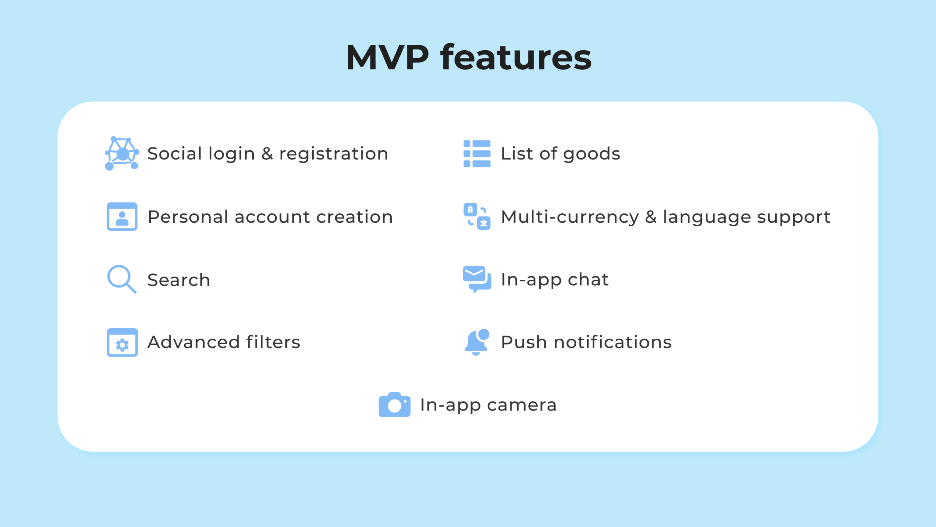
MVP features for buy-and-sell apps
- Social login & registration that boosts users’ trust in your service, making the identity verification procedure easier. Moreover, there’s no need for the customers to manually enter their information because everything would be retrieved from a social network.
- Multi-currency & language support. If you want to have customers from several countries, your app should be comfortable and understandable. So, you should provide them with a multi-currency payment system and several language support implemented in your app.
- A personal account that should show information about buyers and purchasers, as well as all things for sale and a list of contact info. Users must also be allowed to erase their profiles and card data if they need it.
- Search. They might be provided according to the customer’s residence. You should also add the ability to broaden or narrow the search range. It will be simple to implement because most mobile gadgets include a GPS feature.
- A list of goods which should allow customers to choose an article from the list due to particular existing details or add one they need the most. A size guide would also be great to add here.
- Advanced filters required to make the search procedure quick and straightforward. They also save customers’ search time, classifying items by price, size, location, and other categories.
- Automated messages (or push notifications) that will inform the customers about your special offers, events, new goods, services, and other updates by sending them to the user’s chat.
- The in-app camera. It helps users take photos of the needed products and upload them to the app. Moreover, the images can be edited, their size, contrast, and brightness can also be changed.
- In-app chat which allows users to exchange information, discuss the details of various bargains and talk to each other in real-time mode.
More Functionality to Develop the Best LetGo-like App
Now it’s time to upgrade your app and make it unique. Let’s add more functionality appealing to the customers.
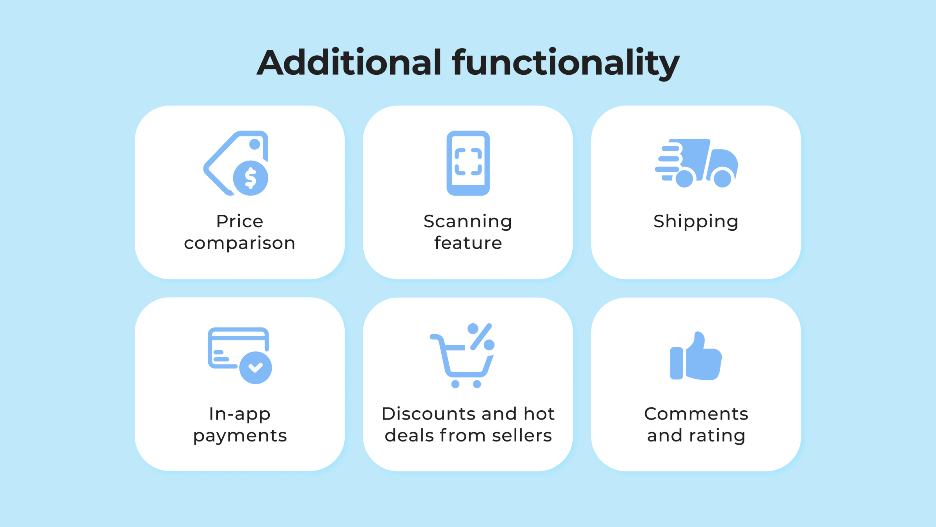
Additional functionality to add to the marketplace solutions
- Rates & comments feature can save buyers from untrustworthy sellers. It also assists in building the clients’ and articles’ reputation due to the merchant’s rating.
- Provide your customers with the best user experience giving them a shipping feature. For that, make an agreement with the external delivery services that will help you ship the needed items on time.
- Price comparison helps users easily find and choose the best articles at reasonable prices.
- Including categories such as top bargains and recent offers is an excellent approach to encourage merchants to enhance their ratings and play fairly. They might also have an opportunity to offer discounts or hot deals to attract more buyers.
- The in-app payment allows users to conduct secure and comfortable transactions without tapping personal data each time required.
- The scanning feature lets you post top-quality live pictures of your article, which is also crucial for buyers.
5 Tips to Consider for Building an Effective App
You can pass through the following steps to achieve app competitiveness and profit.
- Choose an Attractive Name
The app name is the first thing that users see, so it must be theme-based and short. You can use a brand name generator or choose the appropriate title yourself, but think about the target audience’s expectations, semantic load, and other essential things during the process.
- Think About a Catchy UI/UX
If you ask yourself how to create a good web design (or a mobile app one), you should remember and implement its main criteria. This way, it should be seamless and intuitive (as well as the user experience) because the customers would like to use more of the easy-to-use application model they are acquainted with.
- Include a Shopping Cart
The digital shopping cart should be available during the purchasing process. It helps wisely arrange all the items and remove the unnecessary ones. The users should also have an opportunity to proceed to the shipping or payment page depending on their needs.
- Implement a Payment Gateway
Conduct a market and competitor analysis, investigate the most successful buy-and-sell apps developed before yours one and choose the payment gateway comfortable for your app (e.g., Braintree, PayPal, and so on). You should also obey the local government regulations and take care of payment safety and security.
- Plan a Promotional Campaign for Your Product
In order to gain profit, make people think and talk about your product. To obtain such a result, you can choose Google ads to promote your app on various websites — it’s quite an expensive but effective way to attract people. Another successful app promotion way is personalized business applications that also increase customers’ interest in the product.
Fraud Protection
Marketplace platforms process a lot of sensitive financial information (such as user data, invoice details, etc.) That’s why the issue of fraud protection is challenging for customers and app developers.
Fraud prevention is critical when working with merchants accustomed to partnering with highly regulated payment processing networks in buy-and-sell applications. Investing in it today and focusing on collaboration with sellers and mobile network providers is a well-thought-out strategy for future market growth.
So, creating a LetGo (or an OfferUp)-similar app, you should adequately protect it from fraud. This would boost the users’ trust and loyalty. That’s why OfferUp is going to develop fraud prevention mechanisms and invest in customer protection. According to eBay and Craigslist, fraud prevention is essential for a stable market, so these organizations work a lot to provide customers with a safe and secure space.
Wrapping up
Creating a marketplace solution, you should care about its uniqueness and design a correct-working MVP. The qualified software development team will answer all the nerve-wracking questions you have about the development, give a total time and money estimation of your concept, and assist you in building a seamless and profitable solution.
Author bio
Kate Orekhova is a tech writer at Cleveroad. A writer by day and a reader at night, she’s keen on technology and innovations. Her passion is to tell people about the latest tech trends in the world of IT.
